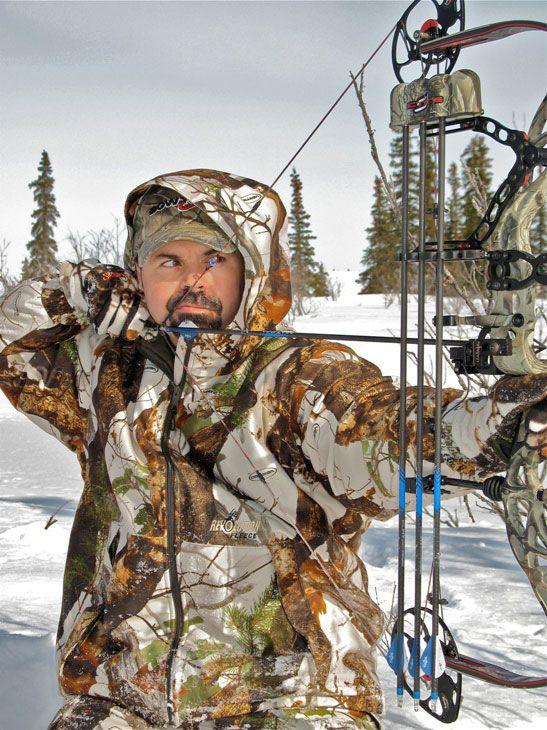
By Paul D. Atkins
My hands were freezing and the thought of drawing back a bow in such cold weather scared me. But the musk ox bull in front of me couldn’t wait, so wrapped in several layers of clothes, I carefully drew the bow back, placing the 20-yard pin right behind his shoulder, all the time praying my bow wouldn’t explode in the -30 degree weather.
Hunting in the extreme can be tough on anybody, especially when you’re using a bow. Unlike a rifle that will usually preform in most conditions, a bow takes special care and attention, but if you’re careful, it is just as deadly as anything you could use.
Hunting the Far North during the months of January, February and March can be brutal. Negative temperatures and fierce winds combined with snow and ice can be tough not only physically, but mentally as well. Making sure you have everything in order and are prepared long before you leave is the key to not only success, but in some cases, survival.
During these winter months there aren’t a whole of seasons open for big game in Arctic Alaska. The hunts that are open are considered subsistence and are usually for residents, but as the year progresses non-resident hunts become available, with spring bears being the most popular. Black bear hunting is legendary come May and June, especially in the southern part of the state, but when you head north the musk ox and grizzly become king.
Musk ox and bear hunting can be tough if you are new to it and even more so if unguided. Most hunts occur when the thermometer is right at or below zero and the area you have a tag for is about the size of Iowa. Then to add to the adventure you have to get to your hunting area and find the animal or animals you’re after in some of the most miserable weather you can experience. Then on top of these extreme temperature ranges you have to be able to shoot your bow where shot placement and shooting in general can be quite a challenge.
Unlike the Lower 48, most of thebig-game seasons here in Alaska end in September, so by March, unless you have been shooting indoors or in some kind of league, getting back in the groove of shooting can be tough. You also have to remember that you will be shooting outside, in who knows what kind of position, bundled up in more clothes than imaginable. Practice is a must and getting your gear to perform in these situations is the key to filling your tag.
Whether bowhunting or using a rifle there are couple things that will enhance the performance and also make it a little safer. One of the first things I do to get ready is store my bow or rifle outside. This way they can acclimate to the cold weather and reduce any stress that can be caused from sudden temperature changes. Bow limbs and risers suddenly taken from a warm environment to extreme cold can go into shock and crack or even worse, explode. I learned this the hard way many years ago while shooting in my own backyard. It was cold, below zero, and after a couple of shots that felt totally wrong, I found the problem. Two cracks magically appeared on both limbs. Expensive lesson learned, but luckily no one was hurt.
Shooting your bow or anything in general is about as grand an experience as I can think of, but shooting it in the extreme cold isn’t much fun. Besides the layers and layers of clothing you have to shoot around you also have to be able to feel the trigger on your release and actually touch your riser. For me this is a tough ordeal. Most people can shoot with gloves on and there are several shooting gloves made specifically for bow hunters; the problem, however, is they are not made for hunting musk ox at 35 below. I have tried to shoot with the big, bulky-type gloves made for the Arctic, but they just don’t work. I’ve also shot barehanded. The burning feeling of skin peeling off your hands isn’t a pleasant one; neither is the frostbite that usually occurs afterwards.I’ve found that cotton glove liners or any of the Sitka line work really well. They fit nicely into an oversized set of mittens along with your release; then when the moment of truth arrives shed the mittens and you’re all set.
Traveling to the place your going to hunt this time of year can be a challenge, too. Most winter/spring musk ox or grizzly hunts are done by the use of snowmachines and sleds. Not unlike getting in your truck or quad and driving to your favorite place to hunt deer or other animals, snowmachines are the normal mode of transport for these types of hunts. You’ll not only have a snowmachine, but also a sled that you pull behind. The sled is to haul all your gear that you will need and in some cases keep you alive. It is also used to get your animal back home.
Most people who hunt want to get away from it all and experience the solitude of the great outdoors. So, if your plans are to chase musk ox or bears in the Arctic then this is about as far away as you can get. Cell phones don’t work, so before you leave you need to make sure you have everything you need to stay alive, but also remember to enjoy your time and make the most out of your cold-weather adventure.
